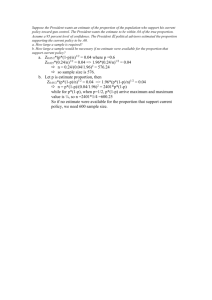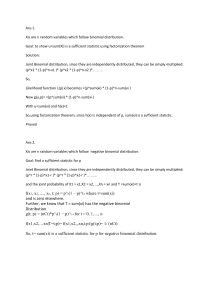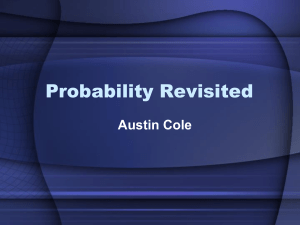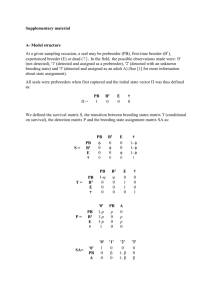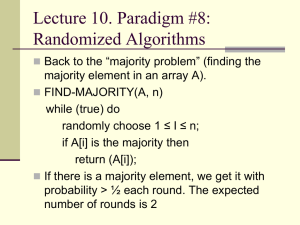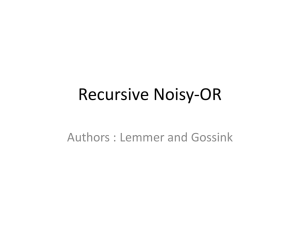10.3
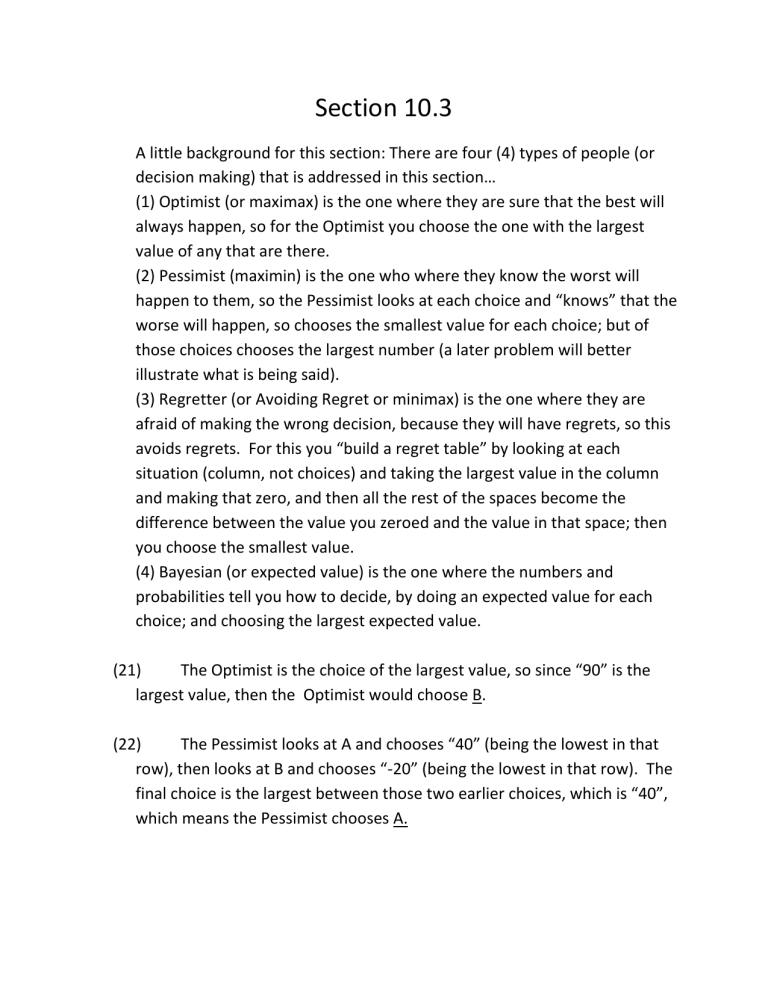
Section 10.3
A little background for this section: There are four (4) types of people (or decision making) that is addressed in this section…
(1) Optimist (or maximax) is the one where they are sure that the best will always happen, so for the Optimist you choose the one with the largest value of any that are there.
(2) Pessimist (maximin) is the one who where they know the worst will happen to them, so the Pessimist looks at each choice and “knows” that the worse will happen, so chooses the smallest value for each choice; but of those choices chooses the largest number (a later problem will better illustrate what is being said).
(3) Regretter (or Avoiding Regret or minimax) is the one where they are afraid of making the wrong decision, because they will have regrets, so this avoids regrets. For this you “build a regret table” by looking at each situation (column, not choices) and taking the largest value in the column and making that zero, and then all the rest of the spaces become the difference between the value you zeroed and the value in that space; then you choose the smallest value.
(4) Bayesian (or expected value) is the one where the numbers and probabilities tell you how to decide, by doing an expected value for each choice; and choosing the largest expected value.
(21) The Optimist is the choice of the largest value, so since “90” is the largest value, then the Optimist would choose B.
(22) The Pessimist looks at A and chooses “40” (being the lowest in that row), then looks at B and chooses “-20” (being the lowest in that row). The final choice is the largest between those two earlier choices, which is “40”, which means the Pessimist chooses A.
(23) To make a regret table, you look at the first column and see that the
“70” is the largest number, so you make that a zero in the table; and in the other box in that column you place the difference between 70 and -20
(70 – (-20) = 90). Likewise with the other column, seeing that the “90” is the largest number, so you make that a zero in the table; and in the other box in that column you place the difference between 90 and 40
(90 – 40 = 50). Giving the following table:
A 0 50
B 90 0
So now it is a matter of choosing the smallest value (other than zero); which in this case is “50”…so the Regretter will choose A.
(24) First note that you only have one probability; the other must make the probabilities add up to one, so the blank probability must be 0.4. Now with that expected value for A is the values times their probabilities (all added together): 70*0.4 + 40*0.6 = 28 + 24 = 52
Now with that expected value for B is the values times their probabilities
(all added together): -20*0.4 + 90*0.6 = -8 + 54 = 46
(25) Using the two results from #24, you choose the largest value, which is “52”, so the Bayesian choose A.
(26) The maximin or Pessimist looks at C and chooses “-5” (being the lowest in that row), then looks at D and chooses “2” (being the lowest in that row). The final choice is the largest between those two earlier choices, which is “2”, which means the Pessimist chooses D.
(27) The maximax or Optimist is the choice of the largest value, so since
“8” is the largest value, then the Optimist would choose C.
(28) To make a regret table, you look at the first column and see that the
“2” is the largest number, so you make that a zero in the table; and in the other box in that column you place the difference between 2 and -5
(2 – (-5) = 7). Likewise with the other column, seeing that the “8” is the largest number, so you make that a zero in the table; and in the other box in that column you place the difference between 8 and 6 (8 – 6 = 2). Giving the following table:
C 7 0
D 0 2
So now it is a matter of choosing the smallest value (other than zero); which in this case is “2”…so the Regretter will choose D.
(29) First note that you only have one probability; the other must make the probabilities add up to one, so the blank probability must be 0.7. Now with that expected value for C is the values times their probabilities (all added together): -5*0.3 + 8*0.7 = -1.5 + 5.6 = 4.5
Now with that expected value for D is the values times their probabilities
(all added together): 2*0.3 + 6*0.7 = 0.6 + 4.2 = 4.8
(30) Using the two results from #29, you choose the largest value, which is “4.8”, so the Bayesian choose D.
(31) First note that you are missing one probability; the probabilities must add up to one, so the blank probability must be 0.3. Now with that expected value for E is the values times their probabilities (all added together): 25*0.5 + 0*0.3 + -5*0.2 = 12.5 + 0 + -1 = 11.5
Now with that expected value for F is the values times their probabilities
(all added together): 10*0.5 + 20*0.3 + -10*0.2 = 5 + 6 + -2 = 9
(32) Using the two results from #31, you choose the largest value, which is “11.5”, so the Bayesian choose E.
(33) The Pessimist looks at E and chooses “-5” (being the lowest in that row), then looks at F and chooses “-10” (being the lowest in that row). The final choice is the largest between those two earlier choices, which is “-5”, which means the Pessimist chooses E.
(34) This is the same question as #33, so has the same answer…E.
(35) The other name for an Optimist is “maximax”.
(36) To make a regret table, you look at the first column and see that the
“25” is the largest number, so you make that a zero in the table; and in the other box in that column you place the difference between 25 and 10
(25 - 10 = 15). Likewise with the second column, seeing that the “20” is the largest number, so you make that a zero in the table; and in the other box in that column you place the difference between 20 and 0 (20 – 0 = 20).
Finally, the third column, seeing that the “-5” is the largest number, so you make that a zero in the table; and in the other box in that column you place the difference between -5 and -10 (-5 – (-10) = 5). Giving the following table:
E 0 20 0
F 15 0 5
So now it is a matter of choosing the smallest value (other than zero);
which in this case is “5”…so the Regretter will choose F.
(37) If we say “p” is the probability of the first column, then the probability of the second column will be (1-p). Then we calculate the expected value of A [ 70*p + 40*(1-p) ] and the expected value of B
[-20*p + 90*(1-p) ] and set them equal to one another…
70*p + 40*(1-p) = -20*p + 90*(1-p)
70p + 40 – 40p = -20p + 90 -90p
30p + 40 = -110p + 90
30p = -110p + 50
140p = 50
Now subtract 40 from both sides
Now add 110p to both sides
Divide both sides by 140 p = 5/14 = 0.3571
(38) Easiest way to answer this is to put in a smaller probability, like 0.3 into the two equation…70*p + 40*(1-p) and -20*p + 90*(1-p)
70*0.3 + 40*(1-0.3) = 21 + 28 = 49 and
-20*0.3+ 90*(1-0.3) = -6 + 63 = 57, so since 57 is larger the answer is B.
(39) If we say “p” is the probability of the first column, then the probability of the second column will be (1-p). Then we calculate the expected value of C [ -5*p + 8*(1-p) ] and the expected value of D
[2*p + 6*(1-p) ] and set them equal to one another…
-5*p + 8*(1-p) = 2*p + 6*(1-p)
-5p + 8 – 8p = 2p + 6 -6p
-13p + 8 = -4p + 6
-13p + 2 = -4p
2 = 9p p = 2/9 = 0.2222
Now subtract 6 from both sides
Now add 13p to both sides
Divide both sides by 9
(40) Easiest way to answer this is to put in a larger probability, like 0.3 into the two equation…-5*p + 8*(1-p) and 2*p + 6*(1-p)
-5*0.3 + 8*(1-0.3) = -1.5 + 5.6 = 4.1 and
2*0.3 + 6*(1-0.3) = 0.6 + 4.2 = 4.8 , so since 4.8 is larger the answer is D.
For problems 41-44 let’s set up the demand/probability table from the text:
Demand 3 4 5 6
Probability
Selling Prob.
26 days 50 days 76 days 48 days
As you can see days do not equal probability, but if you divide the days by the total number of days (200 days) then you will have probabilities:
Demand 3 4 5 6
Probability
Selling Prob.
0.13 0.25 0.38 0.24
And sell probability is calculated by adding up everything from right to left until you get to the probability. For example, if you want the probability of
5, you add 0.24 and 0.38.
Demand
Probability
Selling Prob.
3
0.13
1.00
Now for the specific questions...
4
0.25
0.87
5
0.38
0.62
6
0.24
0.24
(41) The pessimist would choose the smallest probability, which is for 3 cranes.
(42) The optimist would choose the largest probability, which is for 5 cranes.
(43) To maximize the profit you have to know how much profit you will make on a given sale; and in this case is would be $1200 - $800 = $400; also how much loss if you rent the cranes and do not rent them out: -$800
SELL
$400
P
NO SALE
-$800
1-p
The p is the selling probability for the best long term in the above table
(which is what we need to know to answer the question). Next the expected value: 400*p + (-800)*(1-p) and set this equal to zero…
400p – 800 + 800p = 0
1200p - 800 = 0
1200p = 800 p = 800/1200 = 0.6667 add 800 to both sides divide both sides by 1200
Now going back to the table with the selling probability, starting at the right and moving left until you reach the first selling probability that is equal to or greater than 0.6667, which is at 4 cranes.
(44) The largest probability is at 5 cranes, which in a regret table would be zero, and the next largest is at 4 cranes which means the difference between that probability and the next will be the smallest (or the smallest amount of regret).
First a table to represent the information given in the question:
Now it is a matter of using the sell/no sell table below:
Lose Sailboat
$100,000
0.1
Cost is $3800
Not Lose Sailboat
0
0.9
(45) The sailboat owner is definitely favored since in 1 in every 10 cases the sailboat will be lost and the insurance company will have to pay out
$100,000 versus only receiving 10*3800 = $38,000. The offset is that this does not happen very often, so it is more likely that the insurance company will just receive its premium and not have to pay anything out.
(46) The fair price would equal the gross expected value of the “game” as illustrated in the boxes above…100000*0.1 + 0*0.9 = $10,000
Insure
Don’t Insure
Lose Sailboat
$100,000 -$3800
-$100,000
(47) The regret table for the above looks like:
Not Lose Sailboat
-$3800
$3800
Insure
Don’t Insure
Lose Sailboat
0
$196,200
Not Lose Sailboat
$7200
0
On this basis it is better to insure, because the least regret is $7200.
(48) Better to lose a little than lose a lot.
(49) Rewriting the above table without the probabilities:
Lose Sailboat
$100,000 p
Cost is $3800
100000p = 3800
P = 3800/100000 = 0.038
Not Lose Sailboat
0
1-p
The expected value for a “fair game” would be:
100000*p + 0*(1-p) = 3800 divide both sides by 100000
Figure 10.11
Stock
Level 14 15
Possible Demands
16 17 18 19
14
15
16
17
18
19
4.2
3.7
3.2
2.7
2.2
1.7
4.2
4.5
4.0
3.5
3.0
2.5
4.2
4.5
4.8
4.3
3.8
3.3
4.2
4.5
4.8
5.1
4.6
4.1
4.2
4.5
4.8
5.1
5.4
4.9
Prob. 0.12 0.24 0.14 0.20 0.24 0.06
4.2
4.5
4.8
5.1
5.4
5.7
Expected
Profit
$4.20
$4.40
$4.42
$4.32
$4.06
$3.60
(50) Now making this into a regret table…regrets based on probability , regrets based on expected profits and regrets based on individual profits…
Stock
Level 14
14
15
16
17
18
19
Prob. 0.12
1.5
2.0
2.5
3.0
3.5
4.0
15
1.5
1.3
1.7
2.2
2.7
3.2
0
Possible Demands
16 17
1.5
1.3
0.9
1.4
1.9
2.4
1.5
1.3
0.9
0.6
1.1
1.6
0.10 0.04
18
1.5
1.3
0.9
0.6
0.3
0.8
0
19
1.5
1.3
0.9
0.6
0.3
0
0.18
Expected
Profit
0.22
0.02
0
0.10
0.36
0.80
No specific level shows up as a definite choice…if you based it on probability you would choose 16 (the smallest amount of regret that is nonzero … though you may want to select either 15 or 18 since there is zero regret when you base the selection on the other). And if you choose the expected profit you would select 15; and if you select based on individual profits you would select either 18 or 19…SO DEFINITE SELECTION stands out!
Demand
Probability
14
0.12
15
0.24
16
0.14
17
0.20
18
0.24
19
0.06
Selling Prob. 1.00
Cost: 50 cents
0.88 0.64 0.50 0.30
Sale Price: 80 cents
0.06
This table is to be used for problems 51-55. (NOTE: Remember that the selling probability is just adding up everything from right to left.)
(51) The profit for selling is 80 – 50 = 30 cents; and with a “salvage” (being paid for leftovers) being 35 cents, then the possible loss is 50 – 35 = 15 cents.
Sell Don’t Sell
30 cents
P
-15 cents
1 - p
Based on the above table, the expected value (set to zero maximum profit) is: 30*p + (-15)*(1 – p) = 0
30p -15 +15p = 0
45p – 15 = 0
45p = 15 p = 15/45 = 0.33 add 15 to both sides divide both sides by 45
Now looking at the above chart with selling probability, starting at the right on going left until the selling probability is equal to or greater than 0.33… and you get 17 (which is the answer).
(52) The profit for selling is 80 – 50 = 30 cents; and with a “salvage” (being paid for leftovers) being 35 cents, then the possible loss is 50 – 45 = 5 cents.
Sell
30 cents
Don’t Sell
-5 cents
P 1 - p
Based on the above table, the expected value (set to zero maximum profit) is: 30*p + (-5)*(1 – p) = 0
30p -5 +15p = 0
45p – 5 = 0
45p = 5 p = 5/45 = 0.11 add 15 to both sides divide both sides by 45
Now looking at the above chart with selling probability, starting at the right on going left until the selling probability is equal to or greater than 0.11… and you get 18 (which is the answer).
(53) No he would NOT, because all he is looking to do is to lose money…though on some rare occasions he would make some more if he stocked 19, but he always lose money on items 20 and on.
(54) He should buy as many Rutabagas as possible, since he will profit on every one he gets…and more profit is all good.
(55) ZERO, since there is no profit to be made, only loss.
(56) ZERO, since there is no profit to be made, only loss.
